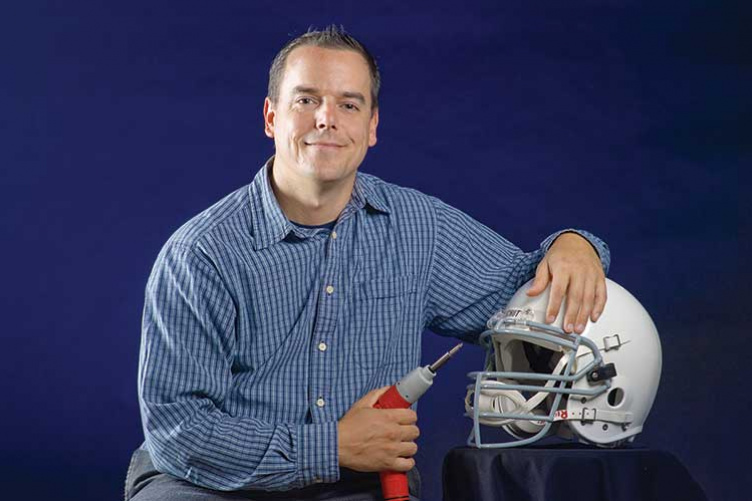
When it comes to head and helmet safety, one of the NFL’s most valuable players isn’t a quarterback, a receiver, or even a coach. In fact, Erik Swartz isn’t a football player at all—the former rugby forward is a professor of kinesiology at UNH.
Swartz, who teaches in the athletic training option and does research on football helmets and other equipment, serves on the NFL’s Head, Neck, and Spine Safety Equipment and Rules Subcommittee. So when the league wanted to evaluate the impact of non-standard facemasks on player safety, they turned to Swartz for the data. His findings led to the league’s much-reported recent banning of overbuilt facemasks for the 2014-15 football season.
With more bars providing greater coverage from the nose down, the masks were popularized by players like Justin Tuck of the Oakland Raiders for their perceived enhanced protection. “There was the thought that these masks would decrease the chance that you’d be able to stick a finger through and poke the player, or to grab the mask and twist it and hurt the neck,” says Swartz.
But after testing the helmets with overbuilt facemasks in his New Hampshire Hall laboratory and in a national impact testing facility, Swartz found that instead of reducing risk of injury, the facemasks potentially increased the risk. Not only could the added weight of the facemask compromise the structural integrity of the helmet, it shifts the head’s center of gravity forward, possibly resulting in fatigue to neck muscles and riskier tackling posture. What’s more, Swartz found that an opposing player’s finger still could get stuck in the smaller spaces of the facemask—and result in serious injury to the opponent’s finger and the player’s neck.
While Swartz’s research means NFL players are sporting standard facemasks this fall, it also has some UNH football players shedding their helmets altogether, albeit temporarily. With the Wildcats as his subjects, Swartz is testing the idea that players could be trained to tackle in a way that reduces head and neck injuries with a series of drills done in practice without protective equipment.
During practices this fall, Wildcat gridders are doing drills according to Helmet-less Tackling Training, or HuTTTM, a system Swartz developed. Players’ helmets and shoulder pads have been wired to determine whether the HuTTTM intervention lessens the impact they take when fully protected.
The two-year study has been funded by the National Athletic Training Association; funding from the NFL,
along with UnderArmour and GE through the national Head Health Challenge, will extend this work to high school football players starting in 2015.
“We anticipate that when the technique is initiated in high school players who are newer to the sport, it can make participation in football safer throughout a career without changing the nature of the game,” he says.
Originally published by:
UNH Magazine, Fall 2014 Issue
-
Written By:
Beth Potier | UNH Marketing | beth.potier@unh.edu | 2-1566

















































